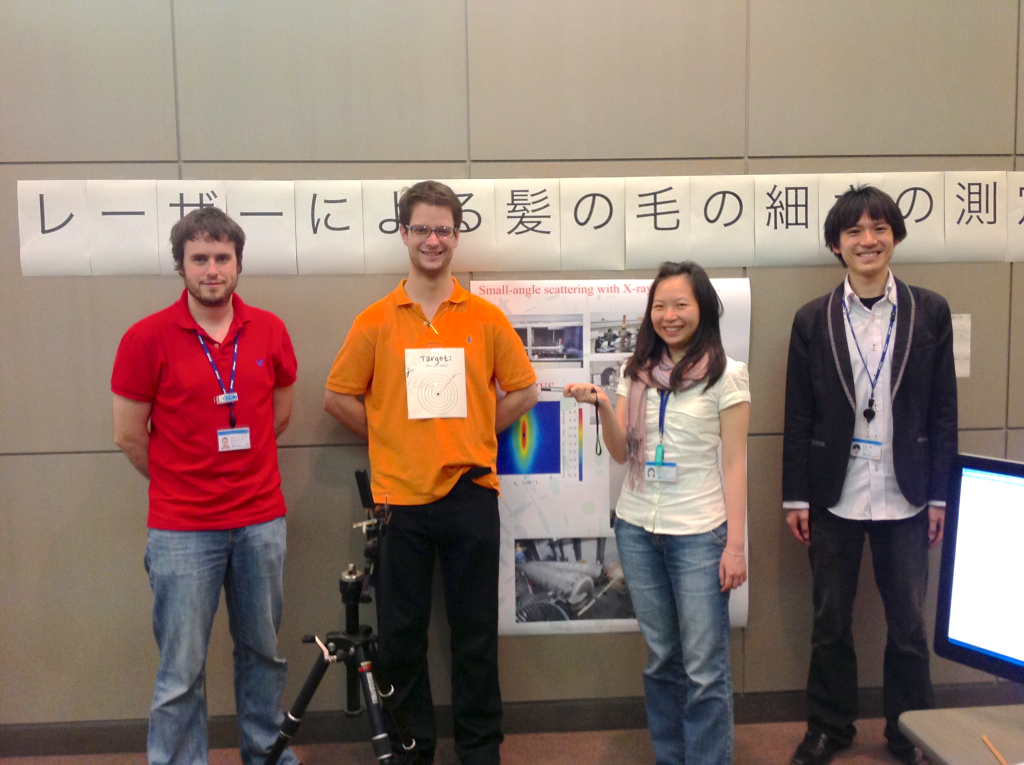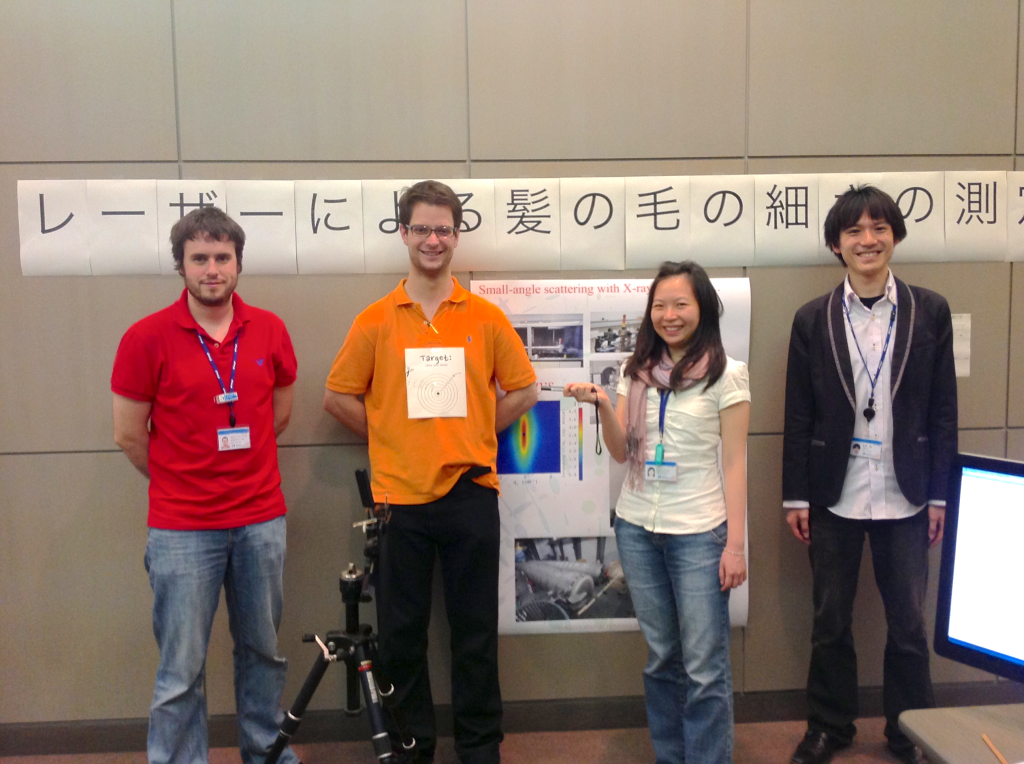
I think it is safe to say that “everyone” is familiar with electron microscopy for looking at small things, but the same cannot be said for small-angle scattering. Introducing more people to the wonderful world of small-angle scattering may be one of the ways of getting more support for and interest in the technique. With this in mind, and with some contacts in the PR department, we managed to get last-minute approval to do a demonstration at the public day at NIMS…

The plan was to have people measure their own hair diameter using a laser in a similar way as demonstrated before in these youtube videos. As I was not expecting more than a few visitors per hour, 5 minutes per visitor was considered a suitable amount of time. To help them, we prepared a step-by-step instruction sheet and some “tools” that the people could cut out and use for their experiment. The procedure was as follows:
- Visitors would be lured in by our blatant advertising to “measure the diameter of your hair using a laser!” (stuck in big letters on the wall, taking up lots of floor space and having a big screen with the program running on it. Also, we had foreigners at our desk in an otherwise very much Japanese event. There was even some Dutch candy!). Visitors would then be given an instruction sheet and some tools.
- They would cut out the tools (one target and one holder for their hair), find a hair and stick it on the paper. Surprisingly, almost everyone could spare one (or had one cut off by one of the staff), and they very much enjoyed the bit of manual labour of cutting out pieces of paper, sticking hair on it and so on.
- Going over to the laser, where the staff mounted the hair in front of the laser (which was a bit finicky work to get it to sit right) using a couple of paper clamps. The laser pointer was forced “on” using another paper clamp holding down the button (the laser pointer itself managed about half a day on a set of batteries, surprisingly).
- Clamping the target onto a clipboard stuck to a tripod, and aligning the central black spot on target with the laser pointer beam, the scattering from a hair becomes clearly visible. The clipboard was about 2m from the hair and laserpointer. At this point I would always take a moment to explain that the central spot was from the laserpointer, but the oscillations were coming from their hair (in my best Japanese).
- We would then ask them to draw arrows in the center of the oscillation spots. This is where it would most often go wrong, as people were unsure on where to draw the points and my Japanese would not be sufficient to explain this. Nevertheless, they had fun drawing points.
- Taking that piece of paper, I would take them to measure the required values: the distance from hair to the target (in meter, with a tape measure if there was time), the number of spots from the target center they could see, the distance from the target center to that last spot (in mm), and reading the wavelength from the laser (green=532 nm, now forever etched in my memory).
- Filling in these values in a Python program (available here) they were then given the diameter of their hair. In the beginning this was set to display the diameter in micrometer, but after an hour or two it became evident that that was not very well known with the public. We therefore changed this to mm. We had our Japanese staff stand at the computer, so he could explain a little about common hair diameters (European: 40 micron, Japanese: 80 micron with the occasional outlier at 110 or 120 micron). Significant digits and uncertainty were a bit of an issue, some wrote down all nine digits resulting from the calculation.
Before I tell a bit more about the experiences on the day, here are the tools you can use (conveniently in English and Japanese):
- The explanation sheet in English and Japanese
- The “tools” sheet in English and Japanese
- The Python program with text in English and Japanese
As this was the first time we did this, we had no idea what to expect. We shared the big lecture hall with three other demonstrations, which helped to draw people to us. We set up the demonstration in a slightly inefficient way, whereas we should have considered the flow of people through the steps. This was exacerbated by the sheer number of visitors. Visitors tended to come in groups of four or more (with the occasional elementary school class to make things really hectic), after which it would be quiet again. Overall, we “served” an estimated 70 people during the 6 hours, which were about 50% schoolchildren and about 50% adults. We had two to four people staffing the set-up at any time.
Ideas we have gained for next time include:
- Setting up the tables a bit better, so that there can be a more logical flow from stage to stage (whilst still keeping it compact), and reserving a separate table for the cutting and sticking-work.
- The set-up using commonly available bits and pieces worked in our favour. Some said they intended to repeat the experiment at home, showing that they noticed it consisted of nothing more than a laser pointer and some paper clamps.
- If we prepare for groups we can explain only once for a group of four or five.
- Staffed stages could be three stages (cutting, measuring and computation) or four stages (cutting, “laser”-ing, measuring, computation). Parallel laser stations would be preferred, perhaps of different wavelength.
- A microscope table can be included for people who want to verify (which should be encouraged if there is time).
- It would be nice if a form was printed with a picture of the measurement with maybe a picture of them, their hair oscillations and the “scientist”-guaranteed number (signatures and such).
I strongly encourage people to try this demonstration at their institute as it was good fun! We’ll do this next year again if we have the chance so do drop by if you have the chance!

Leave a Reply